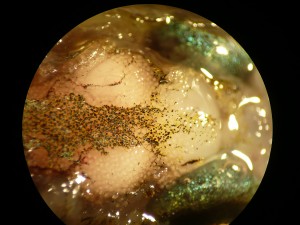Phenotypic manipulation
Parasites can have profound effects on host physiology, behavioral type, and correlations between these traits. Pre-infection, behavior and physiology can […]
Parasites can have profound effects on host physiology, behavioral type, and correlations between these traits. Pre-infection, behavior and physiology can influence the risk of becoming infected by parasites. For example, individuals who are more active may increase their risk of encountering parasites, putting that individual at a greater risk of becoming infected relative to a less active individual. Post-infection, adaptive responses by the host to infection, pathology, or parasite manipulation of host phenotype can modify average host behavior and correlations between behaviors. Reviews on the effects of parasites on host personality traits can be found here and here. I explore interactions between parasites and the phenotype of their host using California killifish (Fundulus parvipinnis) and their phentoypically manipulative trematode parasites.
California killifish are one of the most abundant fish species in the estuaries of Southern California and Baja California. Killifish are host to two phenotypically manipulative trematode parasites. One of these parasites (Euhaplorchis californiensis or EUHA) lives on the fish’s brain, while the other (Renicola buchanani or RENB) lives in the fish’s liver. Infection with RENB and EUHA is associated with an increase in the frequency of conspicuous behaviors in California killifish. These conspicuous behaviors include flashing the killifish’s silvery belly up towards the sun, quick jerks forward, and body contortions. Conspicuous behaviors not only draw the attention of human observers, but also appear to draw the attention of predatory birds. Relative to uninfected killifish, infected killifish are 10-30 times more likely to be consumed by predatory birds, which are the definitive host for both parasites! This is a classic example of parasite behavioral manipulation, in which parasites modify the behavior of their hosts in order to increase their probability of being transmitted to the next host in the parasite’s life cycle. While the mechanisms through which manipulation occurs are still unclear, changes in neurotransmitter activity following infection with EUHA have been documented. These neurotransmitters are associated with behavioral traits and behavioral correlations in other fish species, and so we expect that infection with EUHA may modify numerous aspects of host behavior. A video documenting this manipulation can be found below.
Stress and sex hormones may also play an important role in behavioral interactions between parasites and host behavior, as they both influence host behavior (which could affect the probability of encountering a parasite) and influence immune system functioning (which could increase or decrease the risk of infection given an encounter with a parasite). Additionally, either parasite could be manipulating the production of hormones, with subsequent implications for host behavior. My advisor, Andy Sih, and I are collaborating with the Ecological Parasitology Lab at the University of California Santa Barbara and the Earley Lab at the University of Alabama to explore how killifish behavioral traits and hormones influence an individual’s risk of becoming infected by EUHA and RENB as well as how behavior and hormones change in the killifish following infection. This research is funded through the National Science Foundation, Animal Behaviour Society, University of California Natural Reserve System, the #SciFund Challenge, and the University of California Davis.

